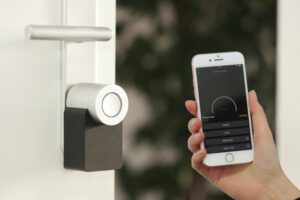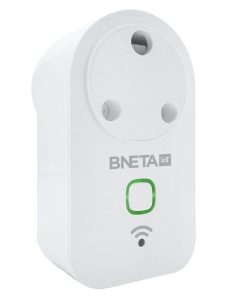Technology is advancing at a pace that very few South Africans are able to keep up with. We’ve all heard about Smart homes and Smart devices but, what exactly are these, how do they work, and how can we make use of them?
With so many advanced smart home security products and setup options, you may think it’s time to say goodbye to your security company. As much as I’d love to agree with that, the truth is the best way to ensure the security of your family and home is by arranging a complimentary set-up between smart home security devices and your regular security company.
We’re going to start this guide off with an overview of your smart device voice control platform options and then move on to discussing how smart devices work. We will then look at a variety of smart devices starting from the simplest smart light bulbs to complex smart indoor alarm systems.
What is a smart home?
There is no set definition of a smart home. It’s a concept that is entirely unique to individual households but will include the use of one or more smart devices. A smart device is simply an electric device that you can communicate with through your mobile phone or a hub interface.
A brief overview of Smart home devices
Smart homes consist of interconnected systems that allow you to manage different aspects of your environment using technology. The most common types of smart homes use sensors, cameras or software applications installed in various parts of the house like lighting fixtures, doorbells or heating systems.
These systems work together within an interconnected network that allows for seamless communication between them through Wi-Fi networks or Bluetooth protocols. This means that you can easily manage every aspect of your living space via an app on your smartphone or tablet device.
How Smart home devices work and their benefits
Smart home devices work by connecting different household appliances such as lights and air conditioning units to each other via a central hub – which may be an app on your phone or tablet device – enabling them to communicate with one another whilst being remotely controlled.
The advantages of this are multifaceted, ranging from energy savings to increased security. For instance, smart lighting systems can be programmed to switch off when no one is in the room, reducing energy waste and saving you money on your electricity bill.
Similarly, smart security systems, such as cameras and door locks, can be controlled remotely via your smartphone or tablet device, keeping you informed about what’s happening in and around your property whilst deterring potential intruders. At the same time, these devices offer convenience by allowing you to control various aspects of your home environment with a simple voice command or tap of a button.
A simple example of a smart device and how it connects to your phone
 Smart bulbs are one of the best introductory smart devices and I recommend you start with this product to get your smart home going. A smart bulb is just like a regular bulb and connects to a light fitting in the same way. The difference is that it is either Bluetooth or WiFi-enabled.
Smart bulbs are one of the best introductory smart devices and I recommend you start with this product to get your smart home going. A smart bulb is just like a regular bulb and connects to a light fitting in the same way. The difference is that it is either Bluetooth or WiFi-enabled.
This means that the light bulb can communicate with your phone via WiFi or Bluetooth. You can then use your phone to communicate with the light bulb to switch it on and off, change its colours or increase and decrease brightness, to name but a few.
- If you are an iPhone user, you have a Home application to which you can add your smart light bulb. You can then say “Hey Siri” and ask her to switch the light on and off.
- If you have an Amazon Alexa station you can say “Alexa, switch light on”.
- If you’re a Google user you can connect your smart bulb to Google Home and ask your Google Assistant to switch your light on and off.
- Microsoft’s Cortana is not a popular smart device assistant and you’ll find very few devices compatible with it.
Now, this is where things get a little messy.
Not all smart devices can connect to all the platforms so if you use an iPhone, some smart devices may not be compatible with the Apple Home App and you will therefore not be able to use Siri to control devices. Likewise, some devices can only work with Google Home and Alexa.
In addition, devices that are not Wi-Fi-enabled will only work when you are within Bluetooth range. To control these devices from anywhere you will need to purchase a hub that will connect all of your devices to your WiFi router.
What is a smart home ecosystem?
 A smart home ecosystem is simply a collection of smart devices which are controlled and managed through a central smart device hub or through a smart home application. Google Home, Apple’s Home, or Amazon’s Alexa are voice assistants which can help you voice control your smart devices.
A smart home ecosystem is simply a collection of smart devices which are controlled and managed through a central smart device hub or through a smart home application. Google Home, Apple’s Home, or Amazon’s Alexa are voice assistants which can help you voice control your smart devices.
You do not need to use a voice assistant to enjoy smart devices or create a smart home ecosystem but, it’s cool and part of the appeal of setting up a smart home in the first place.
Smart Home devices for security you can buy and install yourself
#1: Smart light bulbs
 This is the first smart product that we’re going to delve into are smart light bulbs because they are the simplest to understand and set up and are generally affordable. You can buy a smart light bulb anywhere from R260 to R700. Smart bulbs are simply multi-coloured lights that can be remotely controlled via an application on your Smartphone or via Google Assistant, Siri’s My Home, or Alexa.
This is the first smart product that we’re going to delve into are smart light bulbs because they are the simplest to understand and set up and are generally affordable. You can buy a smart light bulb anywhere from R260 to R700. Smart bulbs are simply multi-coloured lights that can be remotely controlled via an application on your Smartphone or via Google Assistant, Siri’s My Home, or Alexa.
When buying one you need to look at what assistant platform it is compatible with (Android or iOS), whether it’s Bluetooth or WiFi-enabled (which will determine if you need a hub), the number of lumens (the more the better), and, the features it offers such as changing colours and adjusting brightness.
Smart lighting has revolutionised how homeowners approach lighting design in their homes by providing a new level of control over their lighting. Smart light bulbs like Philips Hue allow you to set customised schedules or dim the lights at will via a smartphone app or virtual assistant. With these devices, one can set up “scenes” that adjust brightness and colour according to different moods or times of the day.
#2: Smart cameras
 Almost all new plug-and-play security cameras can be monitored via an app from any mobile phone, tablet, or PC browser. The latest DIY security cameras offer up to 1080P HD resolution, PIR or motion detection, night vision capabilities, emergency notifications, and two-way audio capabilities. With all these features, you can set up a decent home security system, which you can control and monitor remotely from anywhere in the world.
Almost all new plug-and-play security cameras can be monitored via an app from any mobile phone, tablet, or PC browser. The latest DIY security cameras offer up to 1080P HD resolution, PIR or motion detection, night vision capabilities, emergency notifications, and two-way audio capabilities. With all these features, you can set up a decent home security system, which you can control and monitor remotely from anywhere in the world.
It is, however, important to keep in mind that wireless cameras need to be charged and are best for indoor applications. To set up an outdoor CCTV camera system, hardwired cameras that are weatherproof are the best investment. They do not need to be charged, can withstand rain and sun and you’ll never have to worry about lag or poor WiFi connection.
#3: Smart locks
 Smart locks are generally Bluetooth enabled and will require that you install the linked app to set up and control it. The main benefits of a smart lock are that you can open and lock your door without a key, making it ideal for those who have an Airbnb or guest house on their property and that you can monitor the status of your door from your smartphone.
Smart locks are generally Bluetooth enabled and will require that you install the linked app to set up and control it. The main benefits of a smart lock are that you can open and lock your door without a key, making it ideal for those who have an Airbnb or guest house on their property and that you can monitor the status of your door from your smartphone.
That being said, it may be a good device to install in countries with low crimes rates or in highly secure apartment buildings but, in South Africa, we have a few too many gates and doors to get through to make it worth setting up smart locks (from a security perspective). For keyless entry and exit, you will benefit more from installing digital locks which can also connect to your security company.
#4: Smart wall plugs
 Smart home plugs allow you to add everyday appliances and electronics to your smart home ecosystem. They are also either WiFi or Bluetooth enabled and allow you to switch things on and off from your phone or smart hub.
Smart home plugs allow you to add everyday appliances and electronics to your smart home ecosystem. They are also either WiFi or Bluetooth enabled and allow you to switch things on and off from your phone or smart hub.
You can also set a daily and weekly schedule for the plug to automatically go on and off. Some of the higher-end plugs allow you to track electrical usage as well. Smart plugs retail at anything between R280.00 and R600.00. They also come in two and three-point types as well as extension-type smart plugs.
#5: Smart switches
Similar to wall plugs, smart switches will allow you to turn on and turn off one of two devices at a time. You can also set schedules, manage electrical usage, and keep track of power and voltage via the Smartphone app.
Smart switches are not as popular in South Africa as in other countries that are leading the Smart Home trend so you can only find a handful of options, from online stores like Takealot and Builders among others.
#6: Smart home motion sensors
 Motion sensors are by no means new to South Africans who have been using them as an integral part of their home security systems for a very long time. Outdoor motion sensors and beams as well as indoor passives are part and parcel of a home security system that is effective.
Motion sensors are by no means new to South Africans who have been using them as an integral part of their home security systems for a very long time. Outdoor motion sensors and beams as well as indoor passives are part and parcel of a home security system that is effective.
These PIR motion detectors and regular detectors differ from the “non-Smart” versions only in that they are Wi-Fi-enabled and can be controlled and monitored remotely from any device. These sensors can be connected to your home alarm as well as to your security company, so they provide added layers of safety and security.
#7: Smart doorbells and chimes
There aren’t any retailers that currently have Smart doorbells for sale in South Africa. The reason for this is because, in South Africa, unlike in other countries where these smart doorbells are popular, we rarely have people come up to our doors since we usually have perimeter fences and walls, security gates, and dogs, at the very least.
Video intercom systems are therefore much more popular as they incorporate an intercom for you to hear and speak to a visitor as well as a camera. For people that live in flats and, are looking for a doorbell, the Yale wireless door chime bell is a great, hassle-free option for you.
#8: Smart speakers and virtual assistants: Play music or get answers instantly
Smart speakers like Google Home or Amazon Echo (with Alexa) have become ubiquitous not just for music streaming but also for quick access to information (e.g., weather forecasts, news updates). Virtual assistants such as Amazon’s Alexa and Google Assistant can be used to control other smart devices from a central hub and even automate tasks like turning off the lights or adjusting the temperature. With these devices, you can essentially have a personal assistant at your fingertips that responds to voice commands.
How to choose the right Smart home device for your needs
Choosing the right smart home device can be overwhelming, especially with the vast array of options available. However, with the proper guidance, choosing the right smart home device for your needs can be a breeze. The first and most crucial step is to identify what you need in a smart home device.
Do you want to control your lights through voice commands? Or do you want to monitor who comes and goes into your house when you’re not around?
Once you’ve identified what you need, research extensively on the best devices that fit your criteria. It’s also important to consider compatibility with other devices in your home as well as ease of use.
If you already have existing smart home devices, make sure that the new device is compatible. You don’t want a scenario where devices cannot communicate with each other or have limited functionality because they are incompatible. Additionally, consider how easy it is to set up and use the device. A complex setup process may lead to frustration in using it daily.
Lesser known details about Smart home devices
The impact of load shedding on the performance of these devices

Smart home devices are not immune to load shedding and can be affected by power outages. For instance, smart locks that rely on electricity may fail to function during a power outage, leaving your home vulnerable to intruders.
Similarly, smart thermostats may reset their programming during a power outage and return to factory settings. This means that you’ll have to reprogram them again once the power is restored.
However, some Smart home devices come equipped with battery backups or use low-power wireless technologies such as Zigbee or Z-Wave that are not dependent on Wi-Fi or cellular networks. These features help ensure that your smart home devices continue functioning during load-shedding interruptions.
The importance of cybersecurity when using these devices
When it comes to smart home devices, cybersecurity is a critical consideration due to the sensitive nature of data they collect and store. Many smart home devices connect to the internet and use cloud-based services for data storage and remote access, making them vulnerable to cyber-attacks.
For example, hackers can take control of your Smart home cameras or microphones and spy on you without your knowledge or consent. They can also steal personal information such as financial details or passwords stored on your connected devices.
To mitigate cybersecurity risks associated with smart homes, it’s essential always to keep your firmware up-to-date by installing security patches regularly. Additionally, ensure that you have enabled two-factor authentication where possible and created strong passwords for all connected accounts.
Ready to start your Smart home device journey?
Consider factors such as functionality, compatibility with other devices, and cost. When purchasing smart home devices, it is crucial to differentiate between essential and non-essential items to avoid overspending.
Doing thorough research and reading online reviews before making any purchase can also help you avoid buyer’s remorse. One of the challenges facing the adoption of smart home technology in South Africa is high installation costs.
What do you think about smart devices?
Which of the devices listed have you purchased and used in your home? If you’ve found this article useful, please feel free to share it with others and leave a comment below – we’ll love to hear about which product, makes and modules you’re using and what you think of them.
